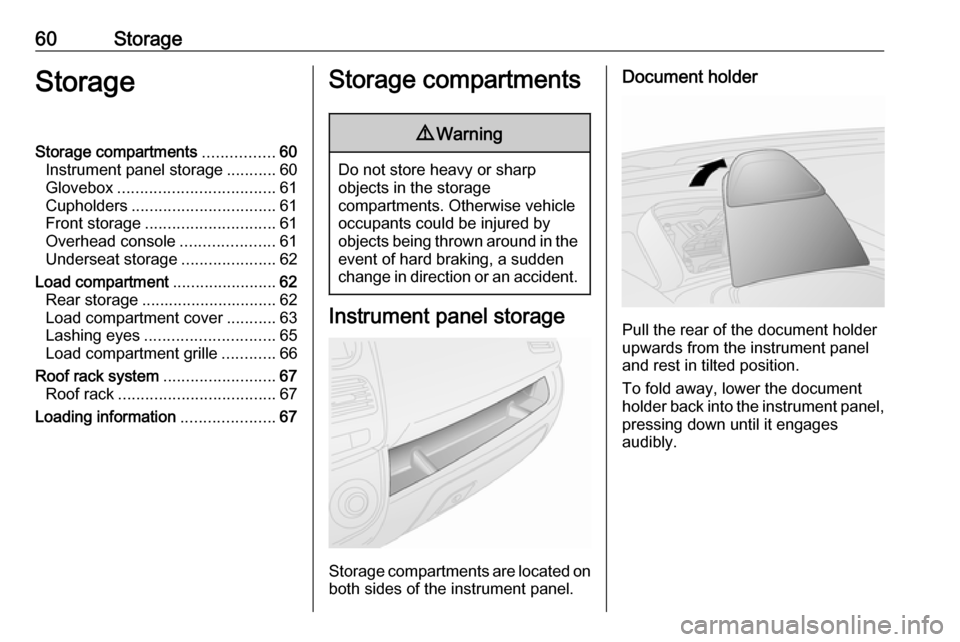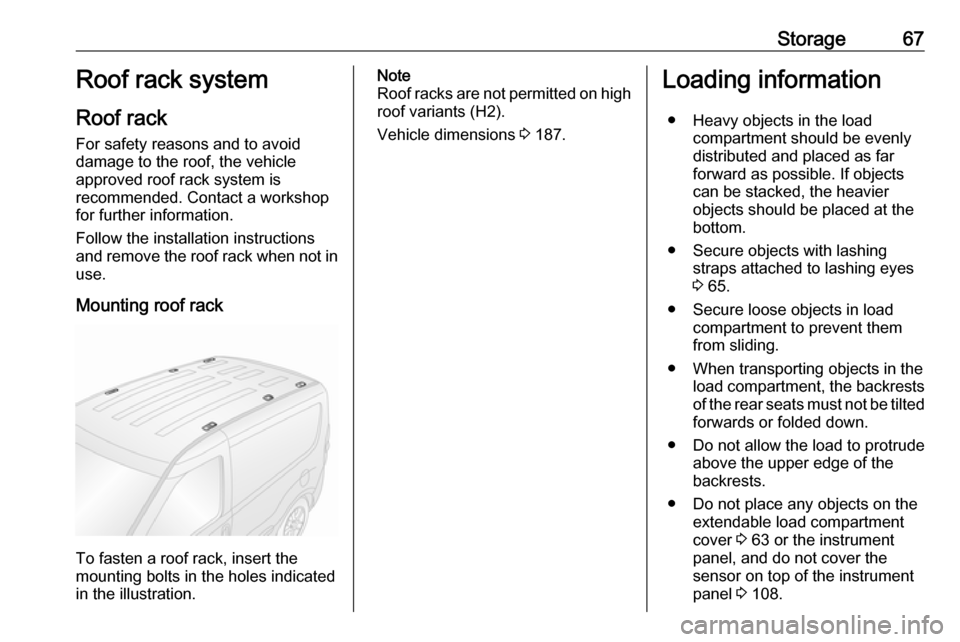roof rack OPEL COMBO D 2017.5 Manual user
[x] Cancel search | Manufacturer: OPEL, Model Year: 2017.5, Model line: COMBO D, Model: OPEL COMBO D 2017.5Pages: 201, PDF Size: 4.76 MB
Page 62 of 201

60StorageStorageStorage compartments................60
Instrument panel storage ...........60
Glovebox ................................... 61
Cupholders ................................ 61
Front storage ............................. 61
Overhead console .....................61
Underseat storage .....................62
Load compartment .......................62
Rear storage .............................. 62
Load compartment cover ...........63
Lashing eyes ............................. 65
Load compartment grille ............66
Roof rack system .........................67
Roof rack ................................... 67
Loading information .....................67Storage compartments9Warning
Do not store heavy or sharp
objects in the storage
compartments. Otherwise vehicle
occupants could be injured by
objects being thrown around in the
event of hard braking, a sudden
change in direction or an accident.
Instrument panel storage
Storage compartments are located on both sides of the instrument panel.
Document holder
Pull the rear of the document holder
upwards from the instrument panel
and rest in tilted position.
To fold away, lower the document holder back into the instrument panel, pressing down until it engages
audibly.
Page 64 of 201

62StorageUnderseat storage
Pull the loop on the seat cushion to
gain access to the storage area.
Load compartment
Rear storage
Storage compartments are located in
the rear door pockets and in the load
compartment sidewalls.
Roof bars
Do not exceed the maximum load
(which includes the weight of the bars) of 25 kg. Always distribute the
load evenly on the roof bars. The load must not obstruct complete closure ofthe doors.
Retighten the fastening screws on the
four brackets periodically.Caution
Do not use elastic lashings, e.g.
bungee cord. We recommend the
use of webbing straps.
Roof bars are designed to be fitted in
a specific position. Proper fastening
of the roof bars cannot be guaranteed if refitted in another position.
No materials (e.g. rubber, plastic)
should be placed between the feet of
the bars and the vehicle body, to
ensure proper fastening.9 Warning
The use of roof bars may affect
steering and vehicle handling.
Removal
To remove the roof bars when not in use:
Page 65 of 201

Storage631. On one side of the vehicle, rotatehandle below first roof bar
(located beneath the bracket) to
loosen, then slide handle inwards
towards centre of vehicle.
2. Repeat above step for the other side of the vehicle.
3. Push up roof bar to release from bracket on both sides and remove
roof bar completely.
4. Repeat above steps for the second roof bar.
5. Unfasten screws on the four brackets to remove the brackets
from the vehicle body.
Load compartment cover
Extendable load compartment
cover
Do not place any heavy or sharp-
edged objects on the extendable load
compartment cover.
Closing
Pull the cover towards the rear using
the handle and engage it in the
retainers at the sides.
Opening
Remove load compartment cover
from the retainers at the sides. Hold
the cover and guide it until it is fully
rolled up.
Page 69 of 201

Storage67Roof rack system
Roof rack For safety reasons and to avoiddamage to the roof, the vehicle
approved roof rack system is
recommended. Contact a workshop
for further information.
Follow the installation instructions
and remove the roof rack when not in
use.
Mounting roof rack
To fasten a roof rack, insert the
mounting bolts in the holes indicated
in the illustration.
Note
Roof racks are not permitted on high
roof variants (H2).
Vehicle dimensions 3 187.Loading information
● Heavy objects in the load compartment should be evenly
distributed and placed as far
forward as possible. If objects
can be stacked, the heavier
objects should be placed at the
bottom.
● Secure objects with lashing straps attached to lashing eyes
3 65.
● Secure loose objects in load compartment to prevent themfrom sliding.
● When transporting objects in the load compartment, the backrests
of the rear seats must not be tilted forwards or folded down.
● Do not allow the load to protrude above the upper edge of the
backrests.
● Do not place any objects on the extendable load compartment
cover 3 63 or the instrument
panel, and do not cover the
sensor on top of the instrument
panel 3 108.
Page 70 of 201

68Storage● The load must not obstruct theoperation of the pedals, parking
brake and gear selector lever, or
hinder the freedom of movement of the driver. Do not place any
unsecured objects in the interior.
● Do not drive with an open load compartment.9Warning
Always make sure that the load in
the vehicle is securely stowed.
Otherwise objects can be thrown
around inside the vehicle and
cause personal injury or damage
to the load or vehicle.
● The payload is the difference between the permitted gross
vehicle weight (see identification
plate 3 180) and the EC kerb
weight.
To calculate the payload, enter
the data for your vehicle in the
weights table at the front of this
manual.
The EC kerb weight includes
weights for the driver (68 kg),
luggage (7 kg) and all fluids (fuel
tank 90% full).
Optional equipment and
accessories increase the kerb
weight.
● Driving with a roof load increases
the sensitivity of the vehicle to
cross-winds and has a
detrimental effect on vehicle
handling due to the vehicle's
higher centre of gravity.
Distribute the load evenly and secure it properly with retaining
straps. Adjust the tyre pressure
and vehicle speed according to
the load conditions. Check and
retighten the straps frequently.
Do not drive faster than
120 km/h.
The permissible roof load (which
includes the weight of the roof
rack) is 100 kg. The roof load is
the combined weight of the roof
rack and the load.
Page 175 of 201

Vehicle care173If using a vehicle wash, comply with
the vehicle wash manufacturer's
instructions. The windscreen wiper and rear window wiper must be
switched off. Remove antenna and
external accessories such as roof
racks etc.
If you wash your vehicle by hand,
make sure that the insides of the
wheel housings are also thoroughly
rinsed out.
Clean edges and folds on opened
doors and the bonnet as well as the
areas they cover.
Clean bright metal mouldings with a
cleaning solution approved for
aluminium to avoid damages.Caution
Always use a cleaning agent with
a pH value of four to nine.
Do not use cleaning agents on hot surfaces.
Have the door hinges of all doors
greased by a workshop.
Do not clean the engine compartment with a steam-jet or high-pressure jet
cleaner.
Thoroughly rinse and leather-off the vehicle. Rinse leather frequently. Use
separate leathers for painted and
glass surfaces: remnants of wax on
the windows will impair vision.
Do not use hard objects to remove
spots of tar. Use tar removal spray on
painted surfaces.
Exterior lights
Headlight and other light covers are
made of plastic. Do not use any
abrasive or caustic agents, do not use an ice scraper, and do not clean them
dry.
Polishing and waxing
Wax the vehicle regularly (at the
latest when water no longer beads).
Otherwise, the paintwork will dry out.
Polishing is necessary only if the paint
has become dull or if solid deposits
have become attached to it.Paintwork polish with silicone forms a
protective film, making waxing
unnecessary.
Unpainted plastic body parts must not be treated with wax or polishing
agents.
Matt filmed body parts or decor tapes must not be polished, to avoid
gleaming. Do not use hot wax
programmes in automatic car washes if the vehicle is equipped with theseparts.
Matt painted decor parts, e.g. mirror
housing cover, must not be polished.
Otherwise these parts would become
agleam or the colour would be
dissolved.
Windows and windscreen wiper
blades
Use a soft lint-free cloth or chamois
leather together with window cleaner and insect remover.
When cleaning the rear window from
inside, always wipe in parallel to the
heating element to prevent damage.
Page 189 of 201
![OPEL COMBO D 2017.5 Manual user Technical data187Vehicle dimensionsTypeVanCombi / Combo TourWheelbaseL1L2L1L2Length [mm]4390474043904740Width without exterior mirrors [mm]1832-18501832-18501832-18501832-1850Width with exterior mirro OPEL COMBO D 2017.5 Manual user Technical data187Vehicle dimensionsTypeVanCombi / Combo TourWheelbaseL1L2L1L2Length [mm]4390474043904740Width without exterior mirrors [mm]1832-18501832-18501832-18501832-1850Width with exterior mirro](/img/37/18807/w960_18807-188.png)
Technical data187Vehicle dimensionsTypeVanCombi / Combo TourWheelbaseL1L2L1L2Length [mm]4390474043904740Width without exterior mirrors [mm]1832-18501832-18501832-18501832-1850Width with exterior mirrors [mm]2119211921192119Height [mm]; Standard roof (H1)11)1895/184512)1927/188012)1895/184512)1927/188012)Height [mm]; High roof (H2) 11)2125212521252125/211513)Wheelbase [mm]2755310527553105Turning circle kerb to kerb [m]11.212.511.212.511)
Without antenna.
12) With/without roof rack installed.
13) Combi/Combo Tour.
Loadspace dimensions
TypeVanCombi / Combo TourWheelbaseL1L2L1L2Length of load compartment floor [mm]182021701400/991 14)1750/1341 14)Length of load compartment floor with front passenger seat folded [mm]30503400--
Page 190 of 201
![OPEL COMBO D 2017.5 Manual user 188Technical dataTypeVanCombi / Combo TourLoad compartment width between wheel arches [mm]123012301230/118615)1230/118615)Maximum load compartment width [mm]171417141230/118615)1230/118615)Load compar OPEL COMBO D 2017.5 Manual user 188Technical dataTypeVanCombi / Combo TourLoad compartment width between wheel arches [mm]123012301230/118615)1230/118615)Maximum load compartment width [mm]171417141230/118615)1230/118615)Load compar](/img/37/18807/w960_18807-189.png)
188Technical dataTypeVanCombi / Combo TourLoad compartment width between wheel arches [mm]123012301230/118615)1230/118615)Maximum load compartment width [mm]171417141230/118615)1230/118615)Load compartment height [mm]; Standard roof (H1)1305130513051305Load compartment height [mm]; High roof (H2)1550155015501550Sliding side door height [mm]1175117511751175Sliding side door width [mm]700700700700Rear door height [mm]; Standard roof (H1)12501250125016)125016)Rear door height [mm]; High roof (H2)14551455145516)145516)Rear door width [mm]12311231123116)123116)14)
With/without folded rear seats (5-seater version only).
15) Combi/Combo Tour (5-seater version only).
16) Combi models with rear doors only.
Roof rack 3 67, Loading information 3 67.
Page 199 of 201

197OObject detection systems ...........131
Odometer ..................................... 76
Oil, engine .......................... 177, 181
Operating windows from outside ..32
Outside temperature ....................72
Overhead console .......................61
Overrun cut-off ........................... 116
P Parking ................................ 19, 119
Parking assist ............................ 131
Parking brake ............................ 127
Particulate filter ........................... 120
Payload......................................... 67
Pedals......................................... 113
Performance .............................. 185
Performing work ........................142
Pollen filter ................................. 111
Power outlets ............................... 74
Power steering fluid ....................144
Power windows ............................ 32
Preheating ................................... 86
Puncture ..................................... 165
R Radio Frequency Identification (RFID) ..................................... 193
Radio info ..................................... 90
Radio remote control ...................21
Rear doors ................................... 26Rear fog light ............................... 90
Rear fog lights ........................... 101
Rear parcel shelf .......................... 63
Rear seats .................................... 41
Rear storage ................................. 62
Rear windows .............................. 34
Rear window wiper/washer .......... 71
Recommended fluids and lubricants ........................ 177, 181
Refuelling ................................... 135 Registered trademarks ...............191
Remote control ............................. 21
Removing seats ............................ 42
Reversing lights .........................101
Ride control systems ..........128, 129
Roof bars ...................................... 62
Roof load ...................................... 67
Roof rack ............................. 67, 187
Roof racks .................................... 67
S Safety belts ................................... 45
Seat adjustment ....................... 7, 37
Seat belt ........................................ 8
Seat belt reminder .......................82
Seat belt reminder warning chime 90
Seat belts ..................................... 45
Seat folding .................................. 38
Seat heating ................................. 40
Seat position ................................ 36Second row seats ........................41
Selector lever ............................. 122
Service ............................... 111, 176
Service display ......................78, 90
Service information ....................176
Settings menu............................... 90
Side airbag system ......................53
Sidelights ...................................... 99
Side turn signal lights ................151
Sliding door .................................. 26
Sliding side door ........................... 26
Spare wheel ............................... 167
Speed limit warning chime............ 90
Speedometer ............................... 76
Standard display ........................... 90
Starting and operating ................114
Starting off ................................... 17
Starting the engine ............115, 122
Steering ...................................... 114
Steering wheel adjustment ......9, 70
Steering wheel controls ...............70
Stop engine .................................. 81
Stop-start system.................. 89, 116
Storage ......................................... 60
Storage compartments .................60
Sun visors .................................... 34
Symbols ......................................... 4